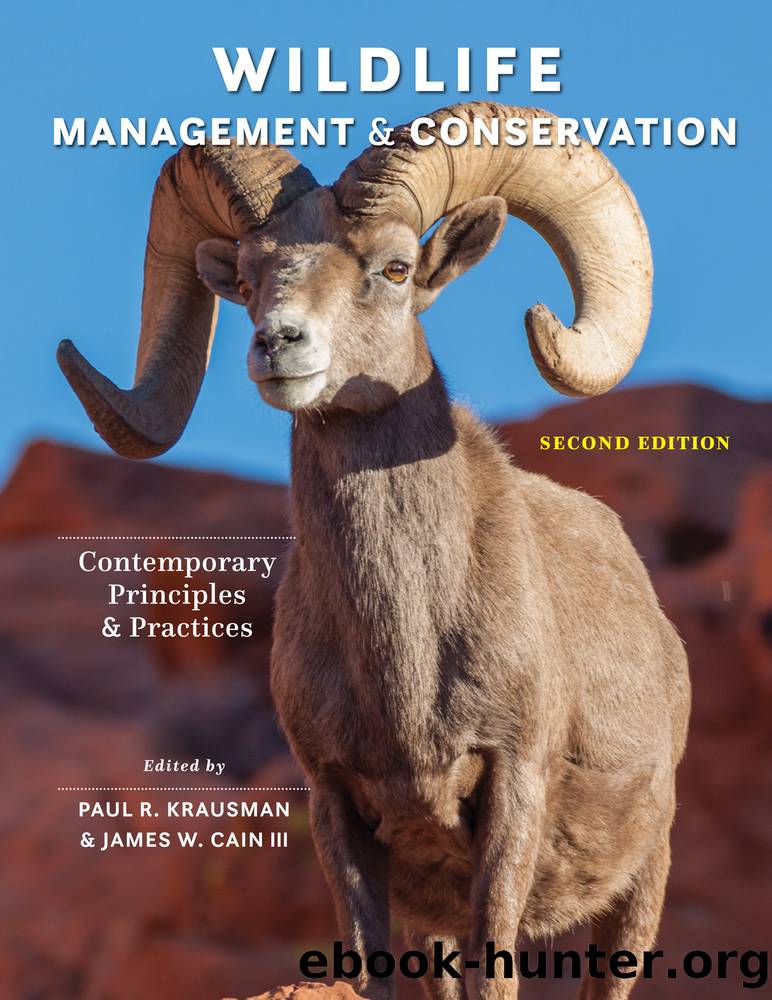Wildlife Management and Conservation : Contemporary Principles and Practices (9781421443973) by Krausman Paul R. (EDT); Cain James W. III (EDT)

Author:Krausman, Paul R. (EDT); Cain, James W., III (EDT)
Language: eng
Format: epub
Publisher: Johns Hopkins Univ Pr
Published: 2022-01-15T00:00:00+00:00
CONSERVATION
Recent evidence for declines of pollinator abundance and diversity has generated concern worldwide (Potts et al. 2010, Ollerton et al. 2011). Declines of pollinators and disruption of pollination services have been reported on every continent on the planet except Antarctica (Kearns et al. 1998). Pollinators are important components of biodiversity and provide important ecosystem services to wild plants and crops globally (Benadi et al. 2013). Declines in pollinator populations and seed dispersers can result in loss of ecological processes and ecosystem services, which will result in significant loss of biodiversity and ecosystem stability. Moreover, because most agricultural crop plants depend on animal pollination, loss of pollinators also will have substantial economic ramifications on human communities (Benadi et al. 2013).
Changing climate with increasing temperatures and increasing concentrations of CO2 has important implications for herbivores and plants. Changing conditions may lead to shifts in plant phenology, or species composition, which may reduce the availability of preferred foods for animals or result in trophic mismatches that could easily reduce recruitment in animal populations (Parmesan and Hanley 2015). Elevated temperatures and concentrations of atmospheric CO2 are predicted to modify plant chemistry and cause increases in secondary compounds in plants, potentially with toxic results for herbivores (Zvereva and Kozlov 2006, Forbey et al. 2013, Beale et al. 2018, Matocq et al. 2020). Zvereva and Kozlov (2006) reported that under increasing temperature and concentrations of CO2, both woody and herbaceous angiosperms had decreased nitrogen concentrations, although the signal was stronger in woody plants.
Giant pandas are an important symbol of international conservation, but they are in decline partly because of declines of their food plants and loss of their habitats. Human societies are continuing to grow and will impose stronger selective pressures on plants and both their herbivores and mutualists as environments change rapidly. Habitat loss and fragmentation, overharvest of animals and plants, and climate change are causing catastrophic declines in plant and animal populations, leading to increasing rates of extinction worldwide (Baranosky et al. 2001, Dirzo et al. 2007, Mittelman et al. 2020). As extinctions increase, ecosystems are becoming more impoverished, and loss of these important community interactions continues to hinder ecosystem function as important ecological processes like pollination and seed dispersal disappear (Kurten 2013, Galetti et al. 2017, Mittelman et al. 2020). Restoration of ecosystems and reintroduction of species in areas of local extirpation are steps toward reversing these losses, but prevention of loss of plants and animals their interactions is an important focus for maintaining biodiversity and thus stability in ecological communities, but it is an uphill battle.
Download
This site does not store any files on its server. We only index and link to content provided by other sites. Please contact the content providers to delete copyright contents if any and email us, we'll remove relevant links or contents immediately.
| Anatomy | Animals |
| Bacteriology | Biochemistry |
| Bioelectricity | Bioinformatics |
| Biology | Biophysics |
| Biotechnology | Botany |
| Ecology | Genetics |
| Paleontology | Plants |
| Taxonomic Classification | Zoology |
Sapiens: A Brief History of Humankind by Yuval Noah Harari(14258)
The Tidewater Tales by John Barth(12610)
Mastermind: How to Think Like Sherlock Holmes by Maria Konnikova(7235)
Do No Harm Stories of Life, Death and Brain Surgery by Henry Marsh(6891)
The Thirst by Nesbo Jo(6838)
Why We Sleep: Unlocking the Power of Sleep and Dreams by Matthew Walker(6620)
Life 3.0: Being Human in the Age of Artificial Intelligence by Tegmark Max(5480)
Sapiens by Yuval Noah Harari(5298)
The Longevity Diet by Valter Longo(5021)
The Body: A Guide for Occupants by Bill Bryson(4979)
The Rules Do Not Apply by Ariel Levy(4870)
The Immortal Life of Henrietta Lacks by Rebecca Skloot(4529)
Animal Frequency by Melissa Alvarez(4400)
Why We Sleep by Matthew Walker(4366)
The Hacking of the American Mind by Robert H. Lustig(4319)
Yoga Anatomy by Kaminoff Leslie(4310)
All Creatures Great and Small by James Herriot(4239)
Double Down (Diary of a Wimpy Kid Book 11) by Jeff Kinney(4210)
Embedded Programming with Modern C++ Cookbook by Igor Viarheichyk(4112)
